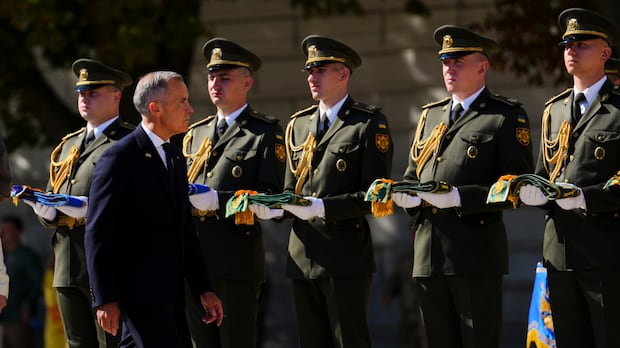The Russia-Ukraine war: Where it stands and where it might be going
In most Western countries, including Canada, the celebration known as flag day is greeted with a kind of benevolent, restrained enthusiasm.
Rarely is it ever a visceral event, the way it has become in Ukraine.
President Volodymyr Zelenskyy brought that sentiment into sharp focus on Saturday, a day before Prime Minister Mark Carney visited Kyiv as a special guest for Independence Day celebrations and pledged Canada's ongoing support of Ukraine.
Zelenskyy noted that up to 20 per cent of his country remains under Russian occupation 3½ years into a full-scale war that sees little bits of Ukraine disappear each day.
"This flag is a goal and dream for many Ukrainians on temporarily occupied territories of Ukraine," Zelenskyy said. "They keep the flag. They keep it because they know that we will not gift our land to an occupier."
More than previous years, the flag as a symbol — and where it flies — is vital to Ukrainians as some western leaders talk of territorial concessions and casually redrawing maps in the name of cutting a deal.
The sentiment was only reinforced on Sunday as Ukrainians marked the 34th anniversary of their independence from the old Soviet Union.

It is the milestone event of Aug. 24, 1991, that Russian President Vladimir Putin has sought to reverse, at first with his proxy war in the eastern Donbas region and with the full-scale invasion of Feb. 24, 2022, that began this latest war.
There are few adjectives left to describe the kind of warfare Ukraine is facing — all of them have been expended.
Somehow, the words brutal, grinding, crushing and unrelenting have lost their power to fully convey what's going on along the more than 1,000-kilometre front line, and the kind of lives that soldiers and civilians alike have to endure on a day-to-day basis.
We read about the daily rain of missiles and drones on cities, towns and villages that are in the line of fire of civilians.
The war on the ground gets less attention.
'This is not fair,' soldier saysIn Sumy oblast, a northeastern province, Ukrainian troops are trading blows with a force of roughly 50,000 Russians, trying to push them back to the border.
A little to the south, the Russians recently advanced near the ruined villages of Lyman, Toretsk and Velykomykhailivka.
Ukrainian forces last week pushed ahead near the strategically vital city of Pokrovsk, in the east, where Russian troops earlier this summer staged a surprise, localized offensive after being tied down for months trying to break Ukrainian supply lines.
A few kilometres here, several hundred metres there — all of it paid for in enormous buckets of blood by both sides.
"So we keep on fighting, and then someone decides we should withdraw because we should give up this or that territory? This is not fair," a Ukrainian soldier with the call sign Motomoto told Reuters this week on the front line in the city of Zaporizhzhia.
His remarks were in response to the spectacle of the Alaska summit, where Putin, meeting with U.S. President Donald Trump, budged not one centimetre from his longstanding demand that Ukraine cede all of Kherson, Zaporizhzhia, Donetsk and Luhansk oblasts in the south and east of the country.
Russia controls only portions of those territories, and Zelenskyy estimated recently that at the current rate of advance, it would take Russia four years to fully occupy the region.
Going into the summit, Trump said both Kyiv and Moscow would need to give up territory in order to end the war.
Zelenskyy, however, kept the Ukrainian flag firmly planted and rejected the call outright when he met Trump last week at the White House.
Even still, according to a Gallup poll released in early August before the summit, 69 per cent of Ukrainians favour a negotiated end to the war as soon as possible. But a public opinion survey in June found 78 per cent of Ukrainians who were polled rejected the demand to transfer unoccupied Ukrainian territories to Russia's control.
In other words — peace, but not any price.
It may be a moot point.
Russia has rejected Ukraine's principle demand for strong security guarantees, backed by the U.S. and NATO, to prevent the war from restarting a few years down the road.
With a stagnant front line and cracks in solidarity between troops at the front and a shell-shocked, war-weary population at home, Ukraine is left with few options except to hit Russians where they live with long-range strikes.
The Wall Street Journal reported this weekend that the Pentagon had prohibited Ukraine's use of some long-range weapons, such as the Army Tactical Missile System (ATMS), a short-range supersonic tactical ballistic missile. The restrictions were quietly put in place as a result of the peace process.
That hasn't stopped Ukraine from using range drones to hit the Russian military and oil infrastructure in Russia and occupied Ukraine in well-publicized attacks.
The day is coming, however, when U.S. restrictions may become meaningless.
Zelenskyy told a news conference last week that Ukraine plans to begin mass production of its domestically developed long-range Flamingo cruise missile this winter.
It could upend the strategic equation with its ability to fly more up to 3,000 kilometres. Making such strikes routine would take the war to a whole new level.
cbc.ca





